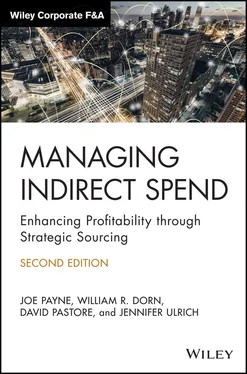Second, when the responsibility of ordering and paying for goods and services falls to multiple people (or groups of people), it usually results in a variety of payment procedures. For example, some locations might run all purchases through a purchase order system and pay via check, while others may pay via a purchasing (credit) card, and others may receive invoices and pay via electronic funds transfer.
Depending on your situation, it may be a good idea to enlist the support of the Finance department, the Information Technology (IT) department, or both. If you are dealing with a situation where multiple ERPs are used, Finance can give you a good indication of how those systems interact with each other. Finance can also shed light on the types of payment options that are used within the organization and how those options are reflected in various ledgers and reports.
IT should also be able to help run the reports you need. In addition, IT may be able to aid in standardizing and consolidating data sets coming from different sources.
If some payments are going to vendors through a procurement card (p‐card), the transactions you pull out of your ERP are only going to reflect payments to your p‐card company, not the vendors you were actually paying. However, most p‐card providers can give you reports that detail whom you have paid with their cards. These reports can be as simple as a list of suppliers and total amounts, or as detailed as a line‐by‐line account of particular items purchased and quantities. If you do not already have access to this data, Finance should be able to provide you with the appropriate reports.
When working with IT or Finance, remember that (during this first pass of data collection and analysis) you are simply trying to identify total spend by supplier over a period of time, normally a year. Two to three years might also make sense if one of your goals is to identify trends over time.
Now that you have collected data sets representing at least one year's worth of spend across all operating units within the organization, the next step is to consolidate and standardize your information. It is important to note that, at this point, the goal is to identify project areas. Capturing line‐item details (such as product purchased, quantity, and price) comes later.
If you are consolidating data yourself, review each data set to determine which columns of information are important. Transaction Date, Supplier Name, and Spend are the three most critical pieces of information. You may want to capture other data as well. Pull this information out of each individual data set and add it to a new consolidated spreadsheet file that includes a column indicating which data set the information came from. For instance, if you pull data for a particular location (let us say location X) out of an AP report for that location, add a column called Location and indicate location X, then add a column called Source Data and indicate AP report.
Once the data are consolidated, it is time to standardize and categorize it. Sort the data by the Supplier field, and create a new column called Cleansed Supplier Name. As discussed previously in this chapter, you may find that each data set has multiple names for a particular supplier. You might even see multiple names within the same data set. Let us use FedEx as an example. If your company makes payments to FedEx, you will probably see this supplier listed as FedEx, Federal Express, FedEx Corp, and so on. In the cleansed supplier name field, standardize all these different options to a single name. Repeat the process for all lines of data.
At this stage, it may not make sense to standardize supplier names across 100% of the data. If you are dealing with hundreds of thousands of records, this could be a very tedious task. If that is the case, utilize the 80/20 rule. Run a pivot table on the data by supplier, then total up the spend. Identify which suppliers make up 80% of the total spend and focus your efforts on standardizing those supplier names. Ignoring 20% of the spend may seem troublesome, but keep in mind that within this data, there are likely to be repeat entries for the same supplier (for example, FedX instead of FedEx). At this point, we are simply identifying target areas. Once we identify worthwhile projects, we then focus on collecting more detailed information. At that point, we will look more closely at the FedX data.
Once you have cleansed and standardized supplier names, it is time to group the data into sourcing categories. Sourcing categories are essentially high‐level identifiers that indicate suppliers that provide the same or similar services. Grouping them together allows you to identify project areas and, eventually, leverage opportunities.
Creating your category list is the first real step in the spend analysis process—turning data into information. Spend analysis is not an exact science. There is no single right or wrong way to do it, but there are some best practices worth considering.
First, be general in your initial classification. Start at the highest level of categorization you can identify. You'll drill down later in the process. For example, you may know that Staples is used for pens and pencils, and Xerox is used for paper products, but categorizing them in different buckets is not appropriate at this time. At its base, the initial spend classification is looking to identify which suppliers provide the same or similar services. Right now, you may use Staples for some items and Xerox for others, but a potential sourcing strategy might be to consolidate all of this spend with a single supplier. So, for now, classify both suppliers under the category Administrative Supplies.
Many suppliers provide a wide range of goods and services. This makes it difficult to classify by name alone. If you have managed to capture any line‐item usage details in your initial data collection, this information can be used to classify the supplier. If a single supplier performs multiple different services or provides multiple, very different types of goods, only one high‐level classification for the supplier should be applied at this time. The final stage of spend analysis is an overall opportunity assessment. Understanding the full impact of a supplier relationship is critical to identifying these opportunities. This high‐level classification will aid that analysis. We'll go into much more detail on the spend analysis and classification processes later in the book.
Once you have completed the initial classification, it is time to start ranking categories for further analysis. Run a pivot table that shows spend by category, then sort the data by spend. You can now see which categories contain the highest spend and therefore have the greatest impact on the organization.
TABLE 2.3Pivot Table with Category and Supplier
| Sum of Total Spend |
| Category |
Supplier Name |
Total |
| Facilities maintenance |
Sai Elevator Company |
$ 1,421,000 |
|
Waste Services Incorporated |
$ 908,312 |
|
Steven's HVAC |
$ 532,127 |
|
Complete Maintenance Solutions |
$ 444,893 |
|
Heating and Cooling Supply Company |
$ 364,459 |
|
Universal Plumbing Associates |
$ 320,276 |
|
Jan‐Tactic Cleaning Services |
$ 200,555 |
|
Maintenance Supplies Unlimited |
$ 143,264 |
| Facilities maintenance total |
|
$ 4,334,886 |
| Marketing |
Franklin Advertising Agency |
$ 2,170,000 |
|
Budget Print Services |
$ 989,767 |
|
Color True Graphic Design |
$ 270,312 |
|
National Printing |
$ 95,000 |
|
Standard Market Research of New York |
$ 62,123 |
| Marketing total |
|
$ 3,587,202 |
| Administrative expense |
Office Max Incorp. |
$ 750,309 |
|
Federal Express Corporation |
$ 546,999 |
|
Warehouse Direct |
$ 506,380 |
|
U.S. Postal Service |
$ 413,075 |
|
Xerox |
$ 311,189 |
|
United Parcel Service |
$ 281,406 |
| Administration total |
|
$ 2,809,358 |
| Grand total |
|
$10,731,446 |
Now, add the Supplier column to the pivot table. You can now see how many suppliers make up each category of spend. Table 2.3 provides an example of an analysis of spend by category and supplier.
Читать дальше












